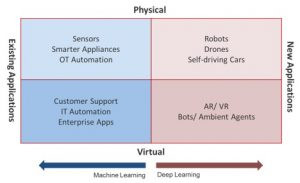Artificial Intelligence Series: Part 2 – Adoption of Machine Learning and Deep Learning in Enterprise
Machine learning and deep learning can be powerful toolkits for enterprise CIOs – but how can you tell which framework is best for your business?
The prospect of deep learning doing all the heavy lifting when it comes to building a prediction model sounds very exciting. However, it poses significant challenges when it comes to organizational problem solving due to the following reasons.
1. Data hunger: Deep Learning often requires millions of examples to train and achieve acceptable accuracy.
2. Compute-intensity: Companies require extensive processing power to train and use deep learning algorithms. Cloud-based compute is usually the most feasible option, but may not sit well with companies that are very guarded about their data going off premise. On the other hand, on-premise servers and staff to run and maintain them are very costly. Not to mention, the highly specialized team required to handle the compute architecture, input data, deep learning framework, and iterations.
3. Model Limitations: Deep Learning is poor at characterizing uncertainty, not appropriate for unbounded problems (it cannot go beyond the data), and is vulnerable to adversarial examples (subtle modifications done to input data to trip a prediction model).
4. Causal inference and transparency: A deep learning-based prediction model is like a black box, making it tough to understand how the algorithm developed the prediction model and make improvements for future performance. Furthermore, there is potential regulatory risk. In light of recent regulations such as EU’s General Data Protection Regulation, companies might be required in the future to share how they are using customer data and “explain” the process of algorithmic decision-making.
This leads us to believe that enterprise use cases most successful right now and over the next few years will use machine learning. We expect mass adoption of machine learning in the enterprise over the next few years, initially to improve existing processes and then reinvent them. Applications that could benefit from machine learning include smart sensors and smarter appliances in IoT, as well as automation across operational technology, information technology, customer support, and enterprise workflows.
While deep learning will eventually make its mark on businesses, it will not be by improving existing applications, but rather by spawning entirely new products and models (think: virtual reality, self-driving cars, drones, etc.).
The diagram below helps illustrate our belief around how machine learning and deep learning will benefit common physical and virtual applications.



